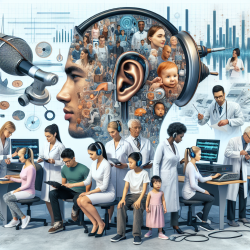Introduction to Audiological Diagnostics
In the field of audiology, diagnostics have evolved significantly, offering a comprehensive suite of tests to identify and quantify hearing disorders. The research article "Current Audiological Diagnostics" provides a detailed overview of these methods, highlighting their application in clinical practice. For practitioners, understanding and implementing these diagnostics can lead to improved patient outcomes, particularly in pediatric settings where early detection is crucial.
Key Diagnostic Techniques
The article categorizes audiological diagnostics into subjective and objective methods. Subjective procedures, such as pure tone audiometry and speech audiometry, rely on patient responses and are crucial for assessing hearing thresholds and speech understanding. Objective methods, including otoacoustic emissions (OAE) and auditory evoked potentials (AEP), provide valuable data on cochlear and neural function without requiring active patient participation.
Implementing Research Findings
Practitioners can enhance their diagnostic capabilities by integrating the following insights from the research:
- Comprehensive Testing: Utilize a combination of subjective and objective tests to cover the full spectrum of auditory deficits. This approach ensures a thorough evaluation of both peripheral and central auditory pathways.
- Focus on Pediatric Audiology: Early detection of hearing impairments in children is vital. Employ techniques like otoacoustic emissions and auditory brainstem response (ABR) testing to screen newborns and young children effectively.
- Data-Driven Decisions: Leverage the quantitative data from objective tests to inform treatment plans. This can lead to more precise interventions, such as the fitting of hearing aids or cochlear implants.
Encouraging Further Research
While the current diagnostics provide a robust framework, there are areas for further exploration. Practitioners are encouraged to engage in research that addresses existing gaps, such as the objective measurement of recruitment or the development of tests for frequency selectivity. Additionally, exploring the application of new technologies, like machine learning, could enhance diagnostic accuracy and efficiency.
Conclusion
The advancements in audiological diagnostics outlined in the research article offer practitioners the tools to significantly improve patient care. By adopting a data-driven approach and staying informed about emerging research, practitioners can ensure they are providing the best possible outcomes for their patients, particularly in pediatric audiology.
To read the original research paper, please follow this link: Current audiological diagnostics.










